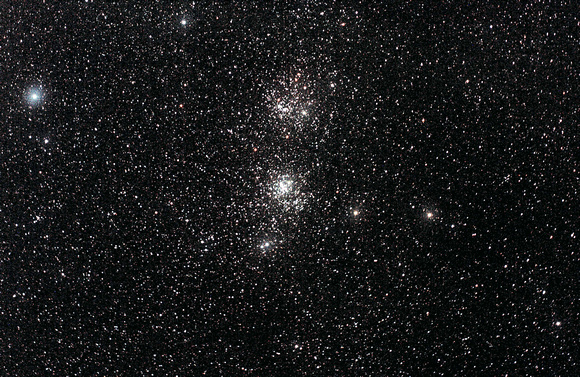Other Names: Caldwell 14
Optics: Borg Astrograph 101ED at f/4.1
Mount: Atlas EQG using The Sky6 and EQMOD
Camera: Canon EOS 50D [ UV/IR filter modification by Hap Griffin ]
Filters: IDAS Light Pollution Suppression (LPS-P2) Filter
Exposure: 25 Mins [5 x 300s at ISO 800]
Accessories: Auto guided with Borg 45ED and Orion Starshoot Auto guider using PHD
Location: Calgary, AB
Date: February 17th, 2012
Notes: Processing: Image acquisition with Maxim DSLR. Image calibration, align, and combine in Maxim DSLR. Levels, curves, Noise Ninja, crop and resize in Photoshop.
Calibrated w/35 Darks, 40 Bias, 40 Flats using light box
Ambient temperature started at -3.6C and finished at -4.4C
The
Double Cluster (also known as
Caldwell 14) is the common name for the naked-eye
open clusters NGC 884 (χ Persei) and
NGC 869 (h Persei), which are close together in the constellation
Perseus. NGC 884 and NGC 869 are at distances of 7600 and 6800 light-years away, respectively, so they are also close to one another in space. The clusters' ages, based on their individual stars, are relatively young. NGC 869 is 5.6 million years old and NGC 884 is 3.2 million years old, according to the 2000 Sky Catalogue. In comparison, the
Pleiades have an estimated age ranging from 75 million years to 150 million years. There are more than 300 blue-white super-giant stars in each of the clusters. The clusters are also
blueshifted, with NGC 869 approaching Earth at a speed of 22 km/s (14 mi/s) and NGC 884 approaching at a similar speed of 21 km/s (13 mi/s). Their hottest main sequence stars are of
spectral type B0.


